Starting out as an illustrator: Advice and resources
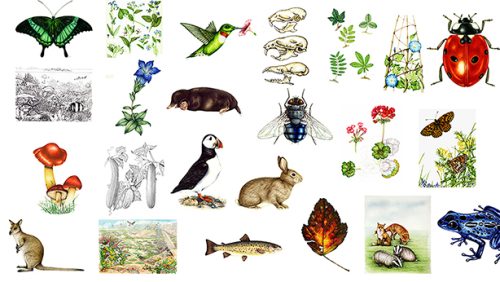
As a practicing natural history and botanical illustrator, I sometimes get asked to give advice to those starting out as illustrators, or considering this as a career path. This happened recently, when I went and spoke to a group of illustration students at Hereford College of Art and Design.
Here, in a nutshell, is what I spoke to them about.
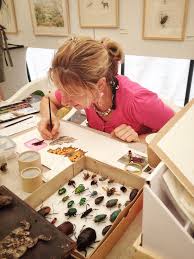
Me at work
Setting up as an illustrator: Preparing
Before you begin your career as an illustrator, there are some steps you should do to make life easier for yourself, and to make you look more professional. First, get a website up and running. Make sure it has your best work on view, is easy to use, has your contact details on, and that you update it regularly (either by posting new work or by blogging about current projects or interests relating to your illustration work.) A good idea is to trawl the internet and see excellent existing illustration sites and use these for inspiration. An excellent place to start is by browsing online illustration advertising sites (more on this later) such as the Directory of Illustration.
You should also set up a separate bank account for your business, so you can keep your finances straight (and the tax man happy). Get business cards made (lots of places do these well and cheaply, a favourite is Moo).
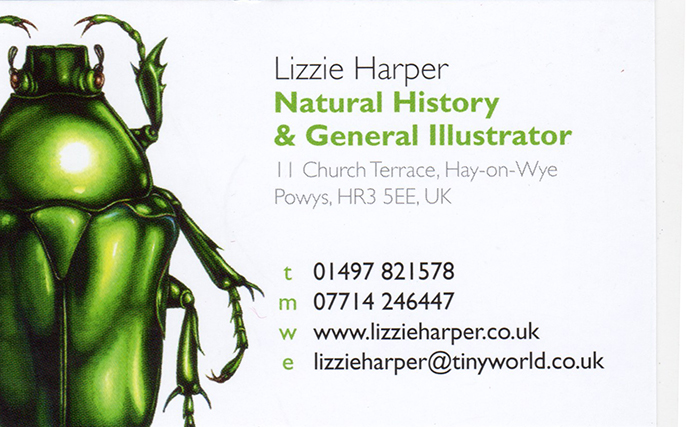
My business card (it needs the email updating to info@lizzieharper.co.uk!)
The Association of Illustrators (AOI)
You need to know where to go for advice. Luckily for illustrators we are blessed with the Association of Illustrators. This invaluable organisation is a one-stop shop for the illustration community. They offer advice on copyright and pricing jobs. They help fight your corner if you’re ever wronged by a client. The AOI produce amazing books on professional practice (ie how to be a good illustrator), and send members a very cool illustration magazine (VAROOM). Join it, it costs, but is worth its weight in gold.
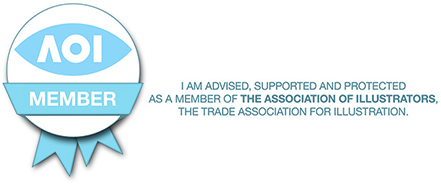
The AOI: you’ll be wanting to join.
You may want to avail yourself of the “portfolio clinic” that the AOI offer, where they look at your portfolio and advise you on what to do to get it as strong as possible. A very useful move, whether you’re fresh from college, or have been in the industry for 20 years (a-hem).
Starting out: Get your portfolio ready
You’ll also want to get your portfolio in tip-top shape. This means pruning off your less good work, pushing your published work, showing the range of styles you work in, and getting it all scanned and ready to be sent to potential clients, either as a link to your website or as JPEGs.
Try to keep it A3 or smaller, and looking smart.
Even though I can’t remember the last time a client asked to see my physical portfolio, I keep it up to date so I know what work I’m most proud of, or which has the highest cache with possible new clients. Also, if a potential client does want to see your portfolio, you need to have it ready to go; they won’t wait around for you to clean it up or update it.
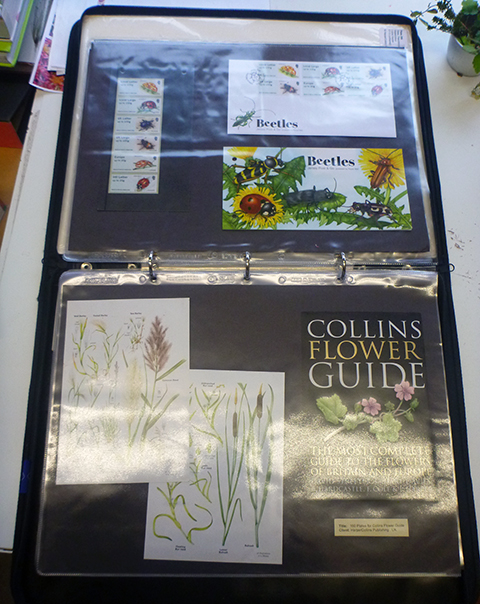
My portfolio
Freelance or not?
A decision you need to make is whether to go free-lance (advertising and getting the work for yourself, sorting out your contract and copyright conditions, negotiating deadlines, chasing the client for feedback and pay, and getting every penny of any job you secure); or to get an agent (who does all the above for you, to some extent, but takes a hefty cut out of your wage for a job. Bear in mind though, agents tend to negotiate higher pay for each job, so it may work out ok.) Agents vary in what they want from and what they offer an illustrator – again, talk to the AOI who have a database of illustration agents and may be able to offer up to the minute advice, or to established illustrators who have worked with agencies.
Getting Illustration Jobs: Advertising your work on Social media
So you’re sorted with a website, portfolio, you’ve joined the AOI and are ready to roll. Now what? First, I’d suggest getting some work published, if you’ve not already done so. The easiest way to do this is to offer to do a small job for free. I wouldn’t normally suggest this as it undermines you and the industry; but at the very start, nothing beats having your illustrations on a poster, information board, design for a shopping bag or anything published in your portfolio. It also means your CV isn’t empty.
Next, you need to advertise. The easiest and cheapest way to start doing this is to take advantage of social media (it’s free!). Set up a facebook page, a twitter account, an Instagram account, a pinterest site, a google plus account, a youtube channel, a LinkedIn profile…whichever takes your fancy, or all of them. Be aware that although they are free, they take time to run (if you don’t update them regularly you may as well not have bothered). Make sure you have contact details and a link to your website on every one; you want people to be able to find you if they like your work.
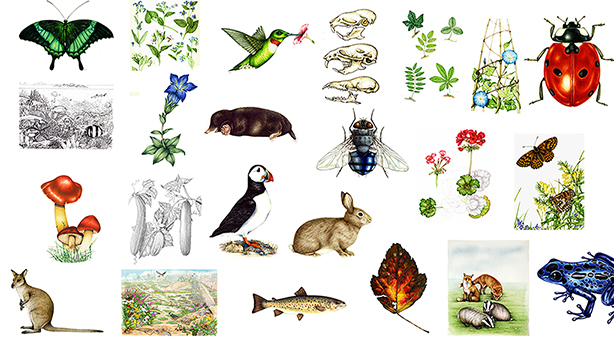
My Youtube banner
Getting Illustration Jobs: Advertising your work in illustration journals
There are also very good advertising annuals for the illustration industry. These cost a bomb to advertise in, but are physical books that get sent out to art directors, publishers, and design companies across the UK and internationally. I have had success advertising with the Directory of Illustration, and the Medical Illustration Sourcebook; a couple of jobs will repay your initial outlay. These have linked online portfolio sites which get plenty of traffic from potential clients.
Getting Illustration Jobs: Mail shots
I also send physical examples of my work to potential and previous clients; this entails keeping an up to date data base of names, companies, and addresses.
Each year (normally at Xmas) I sent out a postcard with my contact details and work samples to everyone on the list.
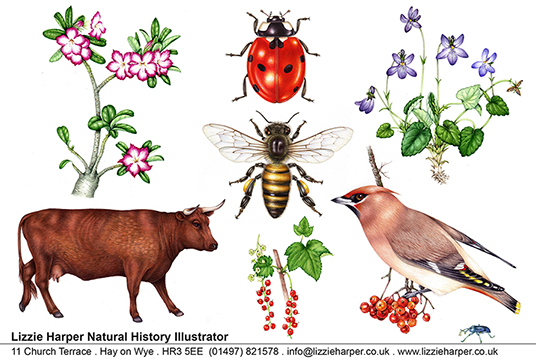
My Christmas promo postcard 2016
Even if these don’t immediately get a return, I know at least some might be pinned up on a notice board, and referred to, maybe many years down the line. This approach is expensive (the cost of producing and posting samples, especially to international clients, is hefty) but has worked time and time again, and has secured me my best clients. One year I even produced an advent calendar which meant my work was on someone’s desk for a whole month. Pricey, but a worthwhile investment.
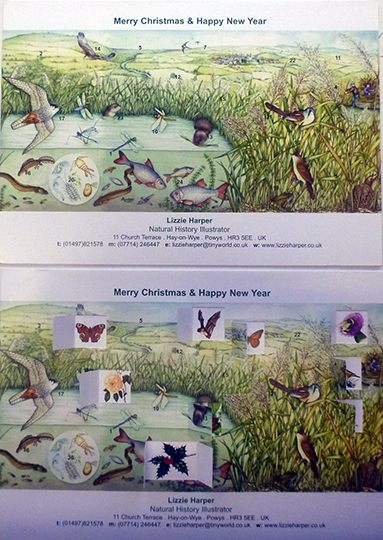
Advent calender sent out Christmas 2009
Getting Illustration Jobs: Client lists
You can also buy up to date lists of art directors and potential clients; either as Client Directories or from companies such as Bikini lists. Target your samples carefully, and bear in mind emails may well be deleted before getting opened. It’s a good idea to follow up any samples you send with a friendly phone call. I find it properly horrid to do, but it often makes all the difference.
Professional Practice: Pricing
So you’ve got a client offering you work – what next? First you need to price the job. Do not (unless you’re starting out and want a published piece for your portfolio) work for free. Many people will ask you to work for free. Refuse, and educate them. For more on this see my blog On Being Asked to Work for Free. Yet again (at the risk of sounding like a one-woman fan-club) the AOI is a great place to start. If you’re a member you can either email or ring and ask for advice, or consult their online (to members only) area where lots of sample job fees and current prices are posted. The amount you get for a job depends far more on how and where the illustrations will be used than on how hard they are to do, or how long they take to complete. Bear this in mind as you price your job (or agree to an offered budget). Some jobs may simply not be worth your time to do; others may not pay well but may be for a company you love. It’s up to you what you offer or accept, but once decided don’t try and raise the price because the job is harder than you envisioned (if the job itself changes of course feel free to negotiate).
Professional Practice: Copyright
Copyright. Ah, where to start? You NEED to know about this. Your copyright is your right as an illustrator to use your pictures as and when you dictate. Many companies (including many publishers) will try to steal this from you. This is often in small print in a standard contract. Fight this, and fight it hard. Do not sell your copyright ever unless you know exactly what you’re doing. Most jobs will only need to use your illustrations once. Write this “one-time usage” into your contract.
The main things to bear in mind are where the illustration can be used, in what context, and for how long.
For more (and I’m afraid you do need to know more) please buy, read, and act on advice in “The Illustrator’s Guide to Law and Business Practice”.
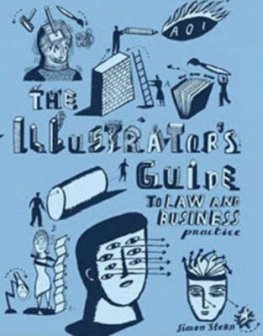
The Illustrators Guide to Law and Business Practice by Simon Stern. Buy this book.
Professional Practice: SORT A CONTRACT!
Next, before putting pencil to paper you need to get a contract sorted, either written by you, or provided by your client.
This will protect you from exploitation. It also makes clear exactly what work you’re going to do, what the price is, what the deadline is, and where the work can be used by the client. This sounds much harder than it is, contracts can be a few sentences long.
An example is “Work consists of an A4 illustration of a red Devon cow, to be completed by June 16th 2016, at the agreed price of £110. Illustration is for one-time usage only by the client, in Europe. Original artwork and universal copyright rest with the illustrator. In case of cancellation or decision not to use the illustration by the client at rough stage, 50% of the final fee is due to the illustrator. Once completed, 100% of the fee is due whether or not the illustration is used. The illustrator will provide the illustration as a high resolution CYMK JPEG scan.”
Again, “The Illustrator’s Guide to Law and Business Practice” has lots more on this, as does the AOI website.

Red Devon Cow
Agree with the client on how you’re going to work. I always provide pencil roughs for comment and approval before working on a full-colour final. This gives the client a chance to make changes without you having to re-do an entire finished illustration.
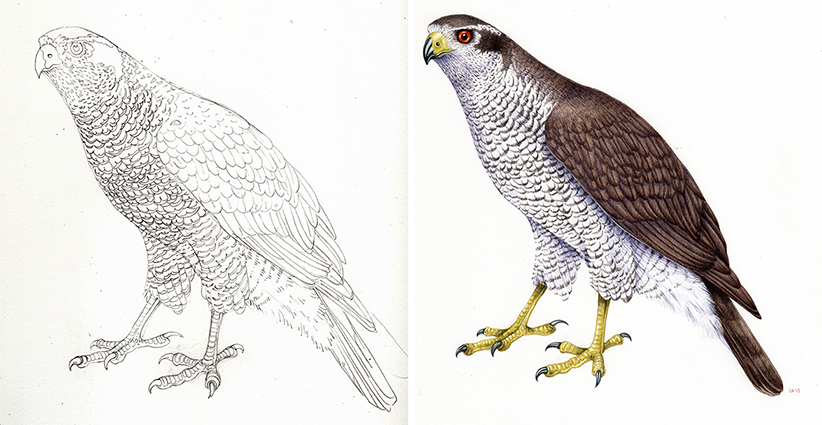
Goshawk pencil rough and finished illustration
Professional Practice: Deadlines
If you don’t think you can hit a deadline, don’t take on the job. Never miss a deadline. The illustration industry is insane. Art directors always commission work at the very last minute, so delays from the illustrator are simply not allowed to happen. If you do miss a deadline, be prepared to never work with that client again. Build this into your thought process when pitching for a job. Remember that no-one will ever be cross if you get an illustration job finished a week early…
At every point in a job, if you have a query communicate with the client. A bit of clarification on a brief, or explaining that a bereavement will cause a delay need to be discussed. Sort it out early to avoid doing lots of unneccessary or wrong work.
Click here to see a very good overview of all this, published by the AOI (from the commissioner’s viewpoint).
Finally, make a note of every job you do. Keep track of the client’s details, keep in touch, even once the job is complete.
Hiring an Illustrator: Things to consider
If you’re on the other end of the relationship, and looking to hire and illustrator; there are many things to consider. Make sure you know what you want from the illustrator, and that you research their style, current market prices, and copyright. Sign a contract with your illustrator, communicate clearly and often, and pay them promptly! For more on this side of the relationship check out this guide to commissioning illustration which covers the topic in more detail.
Being an Illustrator: Branching out
Let’s say it’s all going well and you’re getting the work in. You may find (hollow laugh) that you’re not earning a great deal for your work (see my blog on The Ups and Downs of a Career in Illustration) and need to do more to earn a living.
Here, briefly, are some suggestions that have worked for me or for illustrator friends. Try teaching, maybe one-off courses or a regular stint at an art college. Blogging can, for those with a real talent for it, bring in money from sponsorship. Have exhibitions of your illustrations and sell them; the drawback being that paying for an exhibition and framing and a private view can end up costing more than you sell! Have limited edition prints and greetings cards made of your work. Set up an online shop (maybe with Etsy or Not-on the-High-Street) and sell them. Do demonstrations or talks to groups or charities. Work part-time at a book shop or artists’ materials shop. Don’t give up, no-one said it would be easy.
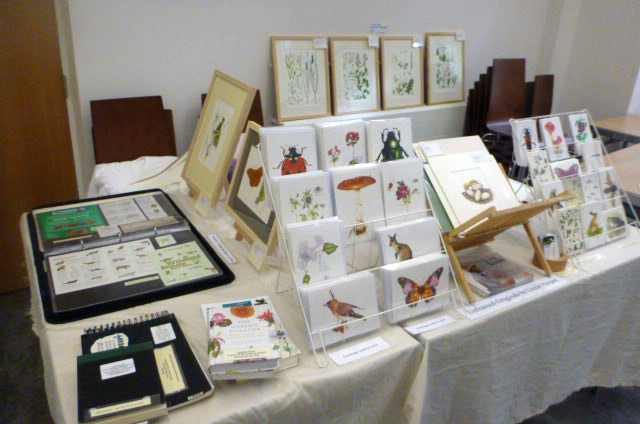
My stall at the New Naturalist’s Conference in 2014.
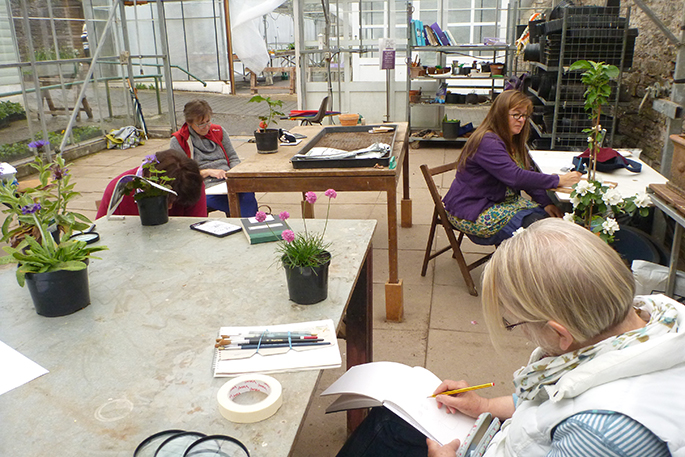
Workshop I taught on botanical illustration in October 2016
Being an Illustrator: Look after yourself
Finally (and apologies for the interminable nature of this blog), you really need to look after yourself. You need to protect your self-worth, your time, your body, and your identity.
Try to separate your work from you as a person, if a client doesn’t like your work try not to feel that you are loathsome, talentless scum; and the world is crashing down on you. It’s just a picture they’re not that into. You need to be your own biggest fan, and you need to work at your self-belief and self-worth. This gets a little easier as time goes on, I promise.
Make sure you don’t work insane hours. Yes, inevitably once every month or so you’ll find yourself alone in a studio pulling an all-nighter. This is fine, just make sure it isn’t happening every week or every night. If it is, turn down work or re-assess your attitude to accepting impossible deadlines. It’s not good for you to go without sleep.
Look out for the physical problems of being an illustrator; bad eyes (focus away from the page or screen every few minutes, get your eyes checked regularly), bad back (stop and walk about, exercise, have back massages), bad hands (shake your hands out every half hour or so). Go jogging or go to the gym, illustrating can be very sedentary so you need to make time to get exercise out of office hours. Remember to stop to eat, and to have cups of tea. Remember to stop to go to bed. Try to keep normal hours and don’t be tempted to nip back and “just finish up” a piece at midnight.
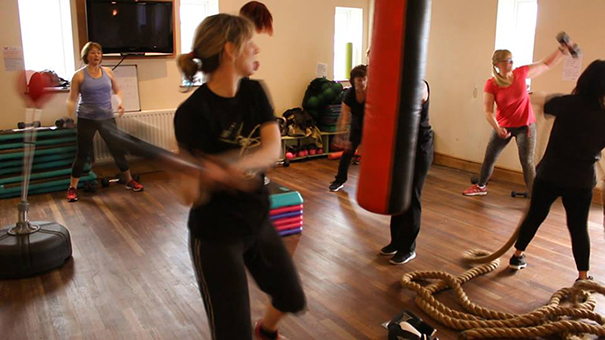
Me giving it some at my local gym
Being an Illustrator: Look after yourself and feed your passions
Make sure you are still a person, not just living through your illustrations. There are things that you love, your passions. In many cases, these may be the very things that made you want to illustrate in the first place, that delight you; continue to indulge in these, irrelevant of the career. For me, this means keeping botanical sketchbooks of wild flowers, going on courses about moss morphology or British slug variety, collecting skulls… These passions still excite me, no matter what I’m drawing for work.
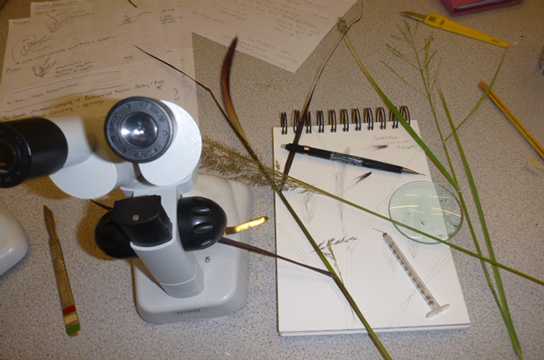
Learning about grasses at an IAPI course – got to love that Poaceae morphology! (well, I do…)
Being an Illustrator: Take time to sometimes be YOU, not only an illustrator
I still have interests that have nothing to do with my job, and my life is crammed with stuff that doesn’t relate to illustration. My family, my friends, travelling, going to the theatre, politics, walking in the rain on lots of hills, eating funnel cake at fairs in Virginia… These things are important, they mean my entire identity isn’t bound up with what I’m drawing. If work goes wrong, I don’t go wrong; I work hard to keep the two things separate.

Me with my daughter, my better half, and a family friend in Fredricksburg Fair, VA
I hope bits of this blog have helped. Take it one step at a time, and don’t be over-whelmed. Start little, dream big, work hard but don’t try to do it all at once. All this advice has taken me about 20 years to accumulate (and act on), and I’m far from being a shining example of how to make it work. I’m sure other illustrators would have an entirely different take on starting out in this industry, and quite possibly a more useful one. Ask around. Network. Talk to people.
As Jane Craddock-Watson at University College of the Arts in Farnham says, “Experience tells us that it’s not necessarily the “most talented” students who are the most likely to succeed, but those who can network, stay positive, create opportunities and build networks as well as be flexible in their approach to their work.” (Varoom magazine, autumn 2016)
No, it’s not an easy career, but if you’re passionate enough about it I promise it’ll be worth it. And good luck!


Fantastic and helpful Lizzie, thank you for making this blog!
My pleasure, hope there’s some useful stuff here. Thanks for the comment!
Good and practical advice filled with many essential points to consider.
Aw, thanks Mary Lou. There is a lot to do when you start out, but I reckon it all becomes second nature after a while. Thanks for your positive comment, I appreciate the feedback!
Is there an American version of the AOI? Thank you!
I believe the AOI operates internationally. Theyre very good at replying to emails, so contact them. If they do have a USA sister branch, Im sure theyll put you in touch. Thanks for the comment.
Hi Lizzie, Great article, thank you for the invaluable advice. I am just starting out as an illustrator and am considering a membership with AOI. I can’t decide between the different types of membership (finances are very tight at the moment). I wondered if you have many leads from your profile on their folio and would you recommend going for that level of membership?
Hi Anna.
I know, deciding what to spend money on when there’s no money there is horrible, I know the feeling well. For me, the services the AOI offer with advice on contracts and their pricing calculator is worth the standard membership. Recently they helped advise me on a job and I ended up asking for (and getting) £2k more for it that I’d been thinking of charging. So that covers costs fast! Yes, people do look at the online website, although I’ve not got figures on how many and if it translated into jobs or not. Lots of what I do in terms of getting work is to get my search terms (botanical illustration, natural history illustration etc) up the search engines. And having folios full of tagged images, on well respected illustration sites certainly helps with this.
Saying that, I also have lots of colleagues who seem to get work in even though they’re not members of the AOi and have a very superficial prescence on line. SO it’s not a necessity, I guess.
What I WOULD say is that the AOI (and their competition the World Illustration Awards) are very highly respected in the industry, so having a folio with them cant hurt. It may not help, but it wont harm.
And that’s what you call an entirely non-committal and hazy answer. Sorry not to have more hard facts to help you decide. ANd thanks for asking, and good luck with it all! x
Thank you Lizzie. This has been so helpful! AOI here I come!
Hooray! Got to love the AOI! Glad to be of use.
Thank you so much for taking the time to write this! Incredibly helpful and inspiring. I’m also a big fan of your work! All the best, Faye
Thanks Faye. And if you’re launching as an illustrator go for it. There really is plenty of work out there if you manage to get your profile under the right noses.
x
I just found your blog and it’s so helpful! I’ve been working as an illustrator for a few years, but somethings it’s still good to read all those things to see if you’re still on the right track. Thanks!
Hi Anna
Thanks for this. Feel free to let me know if there are extra resources out there that you use and value – that’s the nice thing about blogs, I can always edit them to make them up to date. Thanks for the comment, and well done for joining me in the struggle! Hope you’ve still got work coming in during the lockdown.
Stay safe and well
Lizzie
Thank you for this post. It was really helpful and encouraging. I was looking for straightforward and true information about illustration business like that for a long time. Frequently, you can find only ecstatic opinions promising overwhelming success. I am glad you keep to be true in who you are. Maybe it sounds weird, but I found this post very warm and now I feel a bit better and confident. Wishes, Max
Hi Max
Thanks for that. I think it’s so important to be honest about stuff. Certainly, when I was starting out there were times when I thought the whole idea was insane. Even now there are days when I think a job on a supermarket checkout would be a better option, although that tends to be to do with the pressure of deadlines and accounts…. And I also think it’s important to know that doing freelance work and holding a part time job somewhere is entirely normal, it takes a while to get properly established no matter how hard you work or how good you might be. Good luck, the work is there, and if you’re up for playing the long-game, then it’s entirely possible that illustration will prove to be a successfull career choice for you. Thanks again for such a positive and encouraging comment about this blog. x
Awesome article, very helpful, thanks!
My pleasure, I hope its still more or less up to date!
Starting an illustration career? This insightful advice, gleaned from years of experience, offers a roadmap to success. Essential steps include establishing a professional online presence, joining the Association of Illustrators for invaluable resources, and fine-tuning your portfolio. Choose between freelancing and agency representation, each with pros and cons. Social media and advertising in industry journals boost visibility. Crucially, grasp pricing, copyright, and contracts. This comprehensive guide is a compass for budding illustrators navigating the creative landscape.